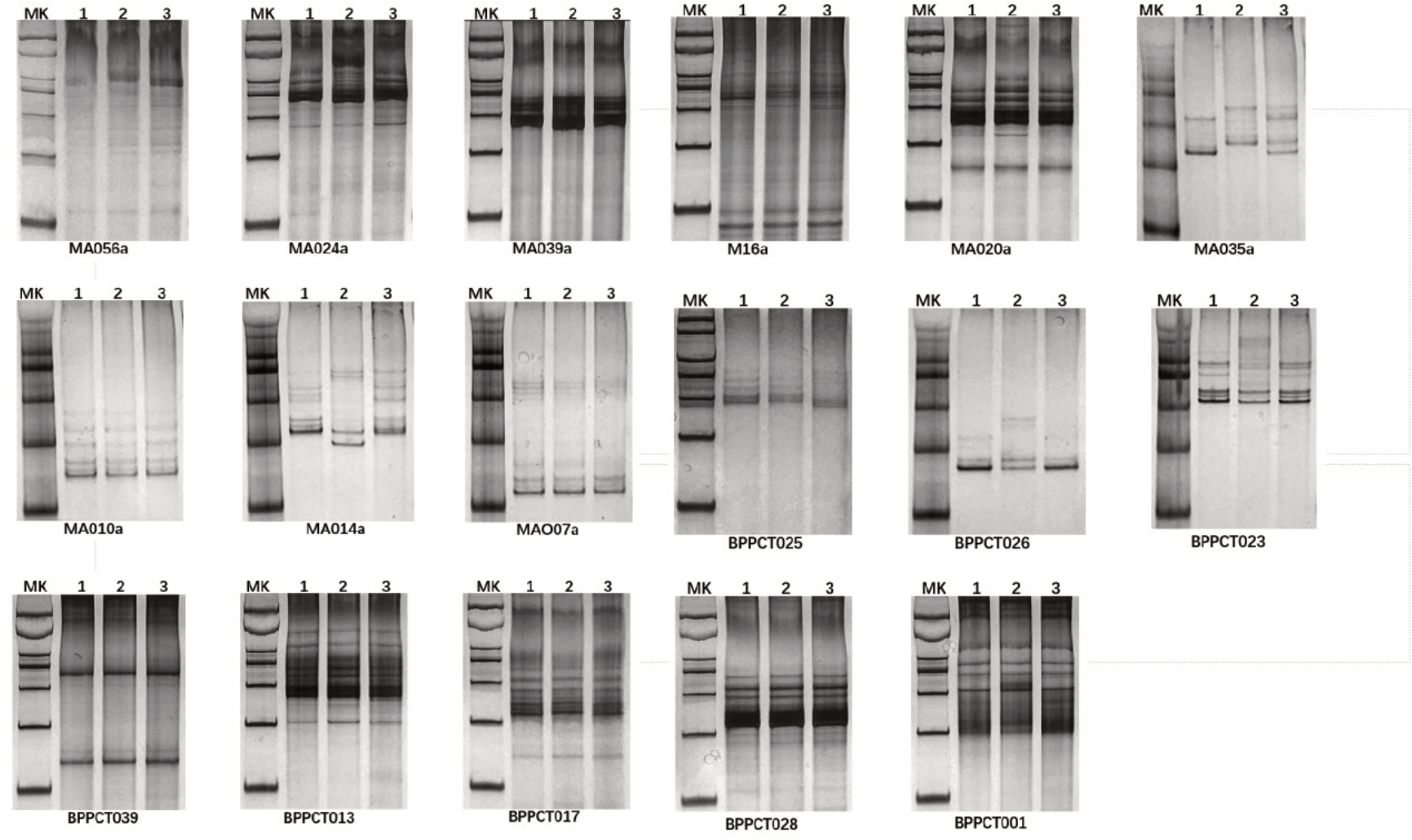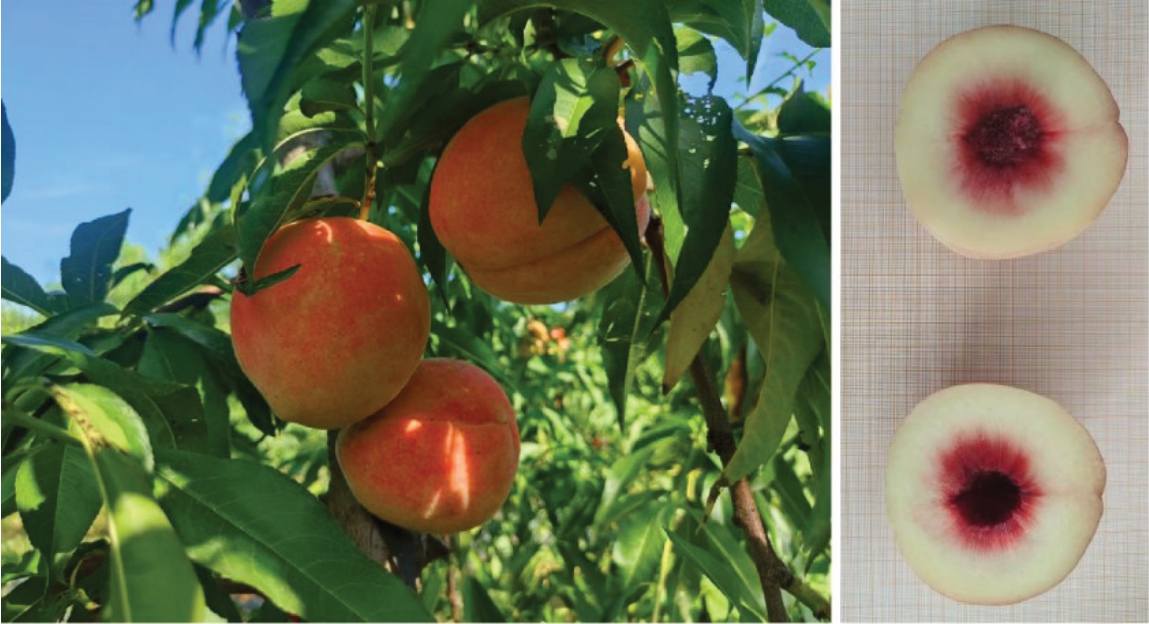桃原产于中国,种植面积和产量均居世界第一位,是我国重要的经济果树[1-2]。河北冀中地区的满城、顺平等地是河北省桃主产区之一,桃树栽培面积1.3 万hm2,主栽品种主要有大久保、燕红、红岗山、大京红等,果实采收期主要在7月上旬到8月中下旬,集中成熟且正值雨季,桃果实品质受降雨影响较大,存在果实风味偏淡、耐贮运性较差等问题。燕红桃采收后,其他品种较少,虽然近年来桃育种工作者相继选育了韦端蜜红、锦冠等较晚熟品种[3-4],但生产上仍缺乏较晚熟、高品质桃品种。
1 选育经过
久爽原代号28-19。2001年河北科技师范学院桃育种课题组在昌黎大久保桃园采集自然杂交种子,取种后就地沙藏。2002年春播种于唐山育种基地温室,苗高达到25 cm后带土移栽至田间,株行距1.0 m×2.0 m,共成活8600株。2004年实生树全部结果,观察并测定果实性状。经连续测定,28-19成为重点优株并开始繁殖苗木。2007年28-19与其他优系及对照品种一起在秦皇岛、保定、唐山、北京等地进行多点试验,测试其适应性和抗逆性,并观察其优良性状的一致性和稳定性。结果发现,28-19优系果实比对照品种大久保桃晚熟25 d,且果实大,着色鲜艳,果形圆,品质优良,适应性强,丰产、耐贮运,且优良性状稳定。2022年对该优系进行DNA分子鉴定,结果表明为新基因型。同年9月,河北省林木品种审定委员会组织专家进行了现场查定,认为该优系优良性状突出,同一世代果实性状、植物学特征及生物学特性表现一致,世代之间表现稳定,与对照品种相比果实成熟期、果实形态特征等方面具有明显的特异性,市场前景良好。根据农业农村部的标准《桃品种鉴定SSR分子标记法》,鉴定结果表明,久爽DNA遗传物质与秋燕、大久保有明显差异(图1)。2023年4月河北省林木品种审定委员会将其定名为久爽(冀S-SV-AP-009-2023)(图2)。
2 主要性状
2.1 植物学特征
主干灰褐色,新梢阳面浅褐色,背阴面绿色,1年生枝条红褐色,叶为长椭圆披针形,花蔷薇型,有花粉。各类果枝均能结果。
2.2 果实主要经济性状
果实圆形,端正,两侧对称,果顶圆平;缝合线中等深度;平均单果质量300 g,最大单果质量540 g,果实底色乳白,果面着鲜红色,着色面积60%;果实各部位成熟度一致;果肉白色,近核处具红色素;硬溶质,汁液较多,黏核;风味甜、微酸适口,有香气;平均可溶性固形物含量(w)13.5%,果肉硬度8.4 kg·cm-2;果实整齐度高,耐贮运(表1)。
表1 久爽桃与亲本品种大久保桃之间的比较
Table 1 Comparison between Jiushuang peach and its parent variety Okubo peach

性状指标Characteristic indicators久爽桃Jiushuang peach大久保桃Okubo peach果顶Top of fruit圆平Round and flat微凹Slight concavity黏离核Sticky or detached kernel黏核Sticky kernel离核Detached kernel肉质Fruit texture硬溶质Hard solute软溶质Soft solute缝合线Suture thread中深Moderate deep较浅Shallow近核处红色素Red pigment near the kernel多Many是否有软沟Soft ditch无No单果质量Single fruit mass/g 300可溶性固形物含量Soluble solids content/%13.5果实发育期Fruit development period/d 140少有24912.0105 Few果皮剥离程度Peel peeling degree of fruit peel不易剥离Not easy to peel off易剥离Easy to peel off Yes
2.3 生长结果习性
树姿半开张,萌芽率高,成枝力较强,复花芽多,长中短果枝均可结果;坐果率高,在满城、滦州、昌黎等地盛果期每666.7 m2平均产量为2182 kg;果实发育期140 d,果实成熟期在冀中地区8月25日成熟,属于中晚熟品种。
2.4 物候期
在保定满城区,4月上旬萌芽,中旬开花,花期7~10 d,果实成熟期在8月下旬至9月上旬,果实发育期140 d,比母本大久保晚熟25 d,11月上旬开始落叶。
2.5 适应性与抗逆性
久爽桃无特殊病虫害,对土壤也无特殊的要求。经过20年多次低温考验,久爽桃未发现有明显受冻情况,直到2024年一直正常开花结果,表明其具有良好的抗寒性和适应性,在桃适栽区可栽培生产。
3 栽培技术要点
3.1 苗木繁殖技术
久爽桃的育苗采用嫁接繁殖技术,适宜砧木为毛桃;嫁接时期在6 月中下旬;嫁接方法用T 形芽接;接后及时剪砧、解绑、幼苗期管理;当年落叶后出圃。如当年来不及嫁接,也可在秋季进行带木质芽接,时间在8月下旬至9月上旬,嫁接时要将接芽包住,以防失水或受冻,翌年开春后解开绑条、剪去砧木,促进接芽萌发。
3.2 栽植密度及树形
适宜的栽植株行距为(2~3)m×5 m;肥沃的平原地区株行距可以适当加大,瘠薄的丘陵山地可适当小些。适宜的树形为开心形、Y字形,树形的培养同其他品种。
3.3 花果管理技术
久爽桃有花粉,自花结实,坐果率高,注意控制产量,合理负载,及时疏花疏果,一般按15 cm 间距留果即可。
3.4 修剪技术
冬剪修剪以长枝修剪为主,重点任务是结果枝组的更新复壮。对于结果枝的修剪“只疏不截”,具体方法是:疏去直立枝、下垂枝、密挤枝、病虫枝,结果枝之间的距离平均掌握在20 cm左右。夏季修剪主要任务是保持树冠通风透光,对于背上直立枝,根据枝叶密度去除或扭伤拉平。
3.5 品质提升技术
为了提升品质,采用“三增三控”技术。三增是增光、增钾、增有机肥,三控是控产、控氮、控水。
增光是打开树体光路,增钾是采收前30 d 每666.7 m2增施硫酸钾25~35 kg,增有机肥指在秋季沟施或撒施发酵好的有机肥,每666.7 m2施入4 m³有机肥、复合肥100 kg、生物菌肥250 kg,也可以使用袋控缓释肥。控产就是控制产量,一般每666.7 m2产量控制在3000 kg左右。控氮是在桃树生长前期适当施氮肥,生长后期不再施入氮肥。控水是在桃果实成熟的前20~30 d尽量不要浇水。
3.6 病虫害防治
久爽桃无特殊的病虫害,重点是及时防治介壳虫、蚜虫、食心虫、红蜘蛛、蝽象、褐腐病、穿孔病等,因该品种成熟期晚,建议套袋栽培。
4 主要缺陷
久爽桃尚未发现明显缺陷,但其为大果型品种,梗洼深而窄,如使用粗壮的结果枝会造成采前落果。因此,在栽培过程多使用中庸或较细的果枝结果。
5 主要用途
久爽桃主要用于鲜食。其成熟期正好在燕红桃之后,为鲜桃市场的空档期,具有较好的市场前景。此外,果实硬溶质,耐贮运,汁液多,风味甜酸适口,有香气,很适合人们鲜食。在适宜桃栽培地区引种栽培,是一个具有发展前景的新品种。
参考文献References:
[1] 俞明亮,王力荣,王志强,彭福田,张帆,叶正文.新中国果树科学研究70 年:桃[J].果树学报,2019,36(10):1283-1291.YU Mingliang,WANG Lirong,WANG Zhiqiang,PENG Futian,ZHANG Fan,YE Zhengwen. Fruit scientific research in new China in the past 70 years:Peach[J]. Journal of Fruit Science,2019,36(10):1283-1291.
[2] 牛良,曾文芳,潘磊,孟君仁,鲁振华,崔国朝,王志强.硬质桃研究现状及展望[J].果树学报,2020,37(8):1227-1235.NIU Liang,ZENG Wenfang,PAN Lei,MENG Junren,LU Zhenhua,CUI Guochao,WANG Zhiqiang. Research status and perspective for stony-hard peach[J].Journal of Fruit Science,2020,37(8):1227-1235.
[3] 李文,曾志芳,陈小梅,潘腾飞,马翠兰,邱栋梁.晚熟桃新品种韦端蜜红的选育[J].果树学报,2023,40(6):1255-1260.LI Wen,ZENG Zhifang,CHEN Xiaomei,PAN Tengfei,MA Cuilan,QIU Dongliang.A new late-mature peach cultivar Weiduanmihong[J].Journal of Fruit Science,2023,40(6):1255-1260.
[4] 叶正文,苏明申,杜纪红,李雄伟,张明昊,周慧娟,张夏南,胡洋.中晚熟鲜食黄桃新品种锦冠的选育[J].果树学报,2023,40(11):2482-2485.YE Zhengwen,SU Mingshen,DU Jihong,LI Xiongwei,ZHANG Minghao,ZHOU Huijuan,ZHANG Xianan,HU Yang.Breeding of a mid-late ripening yellow peach cultivar Jinguan[J]. Journal of Fruit Science,2023,40(11):2482-2485.
Breeding of the new peach variety Jiushuang
WANG Licheng¹,XIAO Xiao2,WU Junkai2,LIU Junming¹,LI Qingquan¹,LIU Jianzhen2,SONG Liqin2,ZHANG Libin2*
(1Mancheng District Nursery,Baoding 072150,Hebei,China;2Hebei Normal University of Science and Technology/Hebei Key Laboratory of Horticultural Germplasm Excavation and Innovative Utilization,Qinhuangdao 066004,Hebei,China)
Abstract:Mancheng and Shunping counties, located in the central region of Hebei Province, are major peach-producing areas within the province. These regions encompass a substantial cultivation area of approximately 13 000 hectare.The main cultivated varieties in this region include Okubo,Yanhong,Honggangshan,Dajinghong,etc.The fruit harvesting season extends from early July to late August.Notably,the peak maturity of these peach varieties aligns with the rainy season,which markedly influences fruit quality.Consequently,the peaches exhibit a flat flavor and reduced resistance to storage and transportation. Currently, this region lacks late-maturing and high-quality peach varieties. Considering the existing gaps in the peach varieties, Hebei Normal University of Science and Technology has engaged in a collaborative breeding initiative with the Mancheng District Nursery in Baoding City,aiming to develop a peach variety characterized by late maturity and exceptional quality. Ultimately, the novel variety Jiushuang was successfully identified and developed from the natural progeny of Okubo.This variety is distinguished as a high-quality honey peach. The cultivar Jiushuang, originally identified as 28-19,was subjected to a rigorous and refined breeding regimen.In 2001,the breeding team at Hebei Normal University of Science and Technology harvested natural hybrid seeds from the Okubo peach orchard in the Changli region,which were subsequently subjected to in situ sand storage.In the spring of 2002, the seeds were sown within the greenhouse facilities at the Tangshan breeding station. Following extensive monitoring and assessment, the superior individual designated as 28-19 was identified as the primary candidate for cultivation, prompting the immediate initiation of seedling propagation efforts.By 2007,extensive multi-site trials in locations such as Qinhuangdao,Baoding,Tangshan,and Beijing,alongside the control variety,were conducted to assess the adaptability and stress resistance of 28-19,as well as to monitor the consistency and stability of its desirable traits. The trial outcomes indicated that the fruit of the 28-19 line matures approximately 25 days later than the control variety Okubo peach.Notably, the fruit from 28-19 is larger, exhibits vibrant coloration, a round shape, and superior quality,while also demonstrating good adaptability,high yield potential,and resistance to storage and transportation,with stable excellent traits.In 2022,DNA molecular analysis was performed on the superior line,confirming its status as a novel genotype. In September 2022, the Hebei Provincial Forest Variety Approval Committee convened a panel of experts for an on-site evaluation,which concluded that the superior line excelled in fruit traits, botanical features, and biological properties, displaying consistent performance across generations.In comparison to the control variety,28-19 trees displayed distinct characteristics in terms of fruit maturity and morphological features,suggesting promising market potential.In April 2023, the Hebei Provincial Forest Variety Approval Committee officially designated this exceptional line as Jiushuang. The fruits of Jiushuang cultivar are spherical in morphology, featuring a flat and even apex along with a fruit suture of moderate depth. The fruits exhibit a basal color of milky white, and the surface is red-colored, with a coloration coverage of 60%. The average single fruit weight is 300 g,featuring white flesh with a concentration of red pigments near the stone.The fruit possesses a firm and soluble texture, accompanied by a cling stone. The soluble solids content is 13.5%,manifesting an optimally palatable sweet-tart flavor profile. The fruit development period spans 140 days,exhibiting the capability of self-fertilization.In the Mancheng District of Baoding City,the Jiushuang fruits ripen between late August and early September.In April 2023,this cultivar was officially endorsed by the Hebei Provincial Forest Tree Variety Appraisal Committee,and it was assigned the premium variety designation with the code:Ji S-SV-AP-009-2023.
Key words:Peach;New variety;Jiushuang


